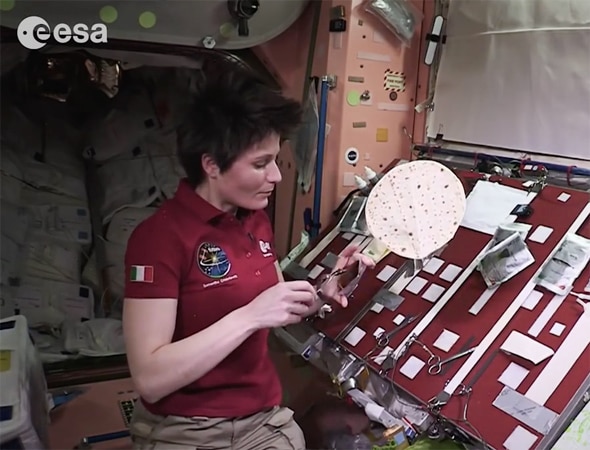Create a free profile to get unlimited access to exclusive videos, sweepstakes, and more!
That’s No Ordinary Taco. It’s a SPACE Taco.

People ask me a lot of questions. One of the most common, understandably, is, “Would you like to go to space?”
My answer is always the same: “I’d like to be in space, but I don’t want to go to space.” The difference being the idea of strapping myself into a chair on top of a 50-meter-high stack of explosives isn’t my idea of fun.
But my answer is a bit of a cheat anyway. Honestly, I don’t even want to be in space. I’d love to soar over Saturn’s rings, orbit low over an asteroid, or dive the cliffs of Miranda … but to do so I’d have to be in free fall, and that—to say the least—doesn’t appeal to me. I have a pretty weak stomach, and I know that being in microgravity* would probably mean me throwing up everything I ever ate ever.
I wish it weren’t true. Weightlessness looks like an awful lot of fun, and it makes everything more interesting. Sleeping, working, everything is different when you’re in free fall.
This was driven home to me when I saw this video put out by the European Space Agency. It came out last year, but I missed it then; happily it’s making the rounds in Facebook again so I stumbled on it. It features one of my favorite astronauts, the Italian spacefarer Sam Cristoforetti, in the International Space Station doing something most of us would take for granted: making a taco.
It’s way different when you’re making … a SPACE TACO.
That’s so cool! I found it fascinating how, no matter how carefully she places the in-progress taco in front of her to float, it always drifts away. Part of that is due to air currents inside the station, but I suspect some of it is that it’s almost impossible to impart zero momentum to it; no matter how carefully you place it, you’ll always bump it or give it a tiny force, and that will make it move away.
She’s pretty good about capturing runaway food bits, too; catching what looks like a bean at 1:22, though she misses one that escapes a couple of seconds later. I hope she cleaned that up before it caused any problems (which should be fine as long as it isn’t ruffled).
My wife is an excellent cook, and one of my favorite meals she makes is fajitas from scratch. It’s always tempting to put too much filling in them because it’s all so good, but that leads to it plopping out the back end when you bite into it (we have a house rule that when that happens, the other person is within rights to yell out, “Rookie error!”). So I was cringing a bit as Cristoforetti made her taco, thinking it might eject glop into the station when she bit into it. It helped that she folded it in half, and also that she didn’t overstuff it, but still it made me think more about this. In space, the filling could stick farther out the back end of the taco without falling off because there’s no force pulling it down, overcoming its own internal cohesion.
While it does lead to fun physics thought experiments, eating in space is weird. But I guess I’ll never know first hand. Still, I—and my tummy—are OK with that.
* Sometimes you’ll hear people say there’s no gravity in space, but that’s not true; the Earth’s gravity on the astronauts in low Earth orbit is about 90 percent the strength we feel on Earth. But they’re moving around the Earth, moving sideways at the same rate they fall toward the Earth, so they fall continuously without ever hitting. That’s why I prefer the term free fall. Microgravity works too because there are still very small forces due to tides and other circumstances, and they really are roughly a millionth as strong as Earth’s gravity. Zero gravity is usually a close enough description, if a wee bit imprecise. I discuss all this in my episode of Crash Course Astronomy on gravity:


























